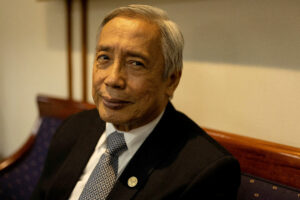




Inflation Update: Green light for easing
 DOWNLOAD
DOWNLOAD

December Economic Update: One for them, one for us
 DOWNLOAD
DOWNLOAD

Philippines Trade Update: Trade trajectories trend along
 DOWNLOAD
DOWNLOAD


BSP sees cross-border payment connectivity in 2-3 years

CROSS-BORDER PAYMENT connectivity may be implemented in two or three years in the Philippines as it seeks to keep up with its Association of Southeast Asian Nations (ASEAN) peers, the Bangko Sentral ng Pilipinas (BSP) chief said on Tuesday.
BSP Governor Felipe M. Medalla said he is looking forward to working with other central banks in the region to ensure cross-border payment connectivity is implemented.
“Our vision really is to be one with ASEAN-5 to have cross-border payments,” Mr. Medalla said in a seminar hosted by Bank Indonesia (BI) in Bali, Indonesia.
In November 2022, the BSP signed a memorandum of understanding (MoU) with other central banks in the ASEAN region to strengthen collaboration on payment connectivity.
The MoU on Cooperation in Regional Payment Connectivity (RPC) was signed with the BI, Bank Negara Malaysia (BNM), Monetary Authority of Singapore (MAS), and Bank of Thailand (BoT) on November 14.
The RPC is expected to contribute in accelerating economic recovery and promoting growth as it aims to foster a more inclusive financial ecosystem by enabling fast, seamless, and cheaper cross-border payments across the region.
Implementation of cross-border payment connectivity will support and facilitate international trade, investment, and other economic activities. The cooperation will include a number of modalities, including QR code and fast payment.
“We will continue to work closely with our ASEAN counterparts to achieve our financial inclusion goals. At the regional level, our arrangements in ASEAN put us in a unique position to engage in knowledge and experience sharing in digital financial inclusion,” Mr. Medalla said.
He also said promoting and facilitating the development of digital infrastructure and platforms is crucial to addressing internet connectivity issues in underserved areas in the country.
By doing so, access of individuals and small businesses to digital financial services may increase, the BSP chief said.
“We want to reduce the number of excluded people to below 30%. The 2021 number is now 44%, and we’re certain that 2023 numbers are much lower and we are on our way towards 30% or lower excluded,” Mr. Medalla said.
Based on BSP data, about 22 million Filipinos gained access to formal financial accounts between 2019 and 2021, but 34.3 million adults remained unbanked. This brought the country’s banked population to about 56% of all adults in 2021, up from just 29% in 2019.
Meanwhile, the share of digital payments in the total volume of retail transactions in the country rose to 30.3% in 2021 from 20.1% a year earlier. The value of payments done online also represented 44.1% of total retail transactions last year.
The BSP wants 50% of total retail transactions done digitally and to bring at least 70% of Filipino adults into the financial system by this year under its Digital Payment Transformation Roadmap.
“Indeed, although we are a traditional central bank that is very concerned with price stability…all of these three strong pillars, it’s a pity if it’s not inclusive. Financial inclusion is a very important part of our strategic objective,” Mr. Medalla said.
Last week, the BSP and four other central banks in the region announced it will connect their domestic instant payment systems (IPS) through the Bank for International Settlements’ (BIS) Nexus Project.
The Nexus, a prototype developed by the BIS Innovation Hub Singapore Centre, connects payment system operators with the Eurosystem’s TARGET Instant Payment Settlement (TIPS), Malaysia’s Real-time Retail Payments Platform (RPP) and Singapore’s Fast and Secure Transfers (FAST).
Based on the MoU on Cooperation in RPC, the BI, BNM, BSP, MAS and the BoT will leverage experiences from Phase I and Phase II of the Nexus project to connect IPS and facilitate cross-border transactions for about 500 million people in the region. — Keisha B. Ta-asan
This article originally appeared on bworldonline.com





 By BusinessWorld
By BusinessWorld